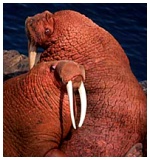
 Long in the Tooth Both male and female walruses have long ivory tusks, although the tusks of the males tend to be longer and thicker than those of females. The tusks are the walrus' very long upper canine teeth, and they grow to an average length of about 36 cm / 14 inches, but they can grow as long as 100 cm / 39 inches in males. (This makes Dracula seem sort of puny, doesn't it?).
However, the main role of the tusks is a social one, and walruses use them in dominance and mating displays. They are only secondarily used as weapons, but when walruses cross tusks, there are often injuries involved. The scars seen on the necks and shoulders of adult males are evidence of tusking.
Arctic: Library and Links Arctic Animal: Library and Links Library: Polar Bears and Whales Arctic Maps & Weather Reports |

|
DICTIONARY: Just "double-click" any unlinked word on this page for the definition from Merriam-Webster's Student Electronic Dictionary at Word Central. |

|
ARCTIC LIBRARY & GLOSSARY: Check this section for an index of the rest of the things you really need to know about the Arctic. |

|
ARCTIC MAPS & WEATHER REPORTS: Maps of the Northwest Passage, explorers' routes, iceberg sources, Nunavut, the Arctic by treeline, temperature... |

|
ARCTIC LINKS: Even more information! Links to sites related to the Arctic and "Iceberg: the Story of the Throps and the Squallhoots". |

|
GUIDE TO ARCTIC SUNRISE & SUNSET: How much sunlight or darkness is there in the Arctic on each day of the year? |
|
Search for more on this topic...from Athropolis! Select the search engine (up to 4 at one time), enter your request, and click "Search". ( Search Tips ) |
to is the property of their respective owners, and Athropolis is not responsible for their content.
